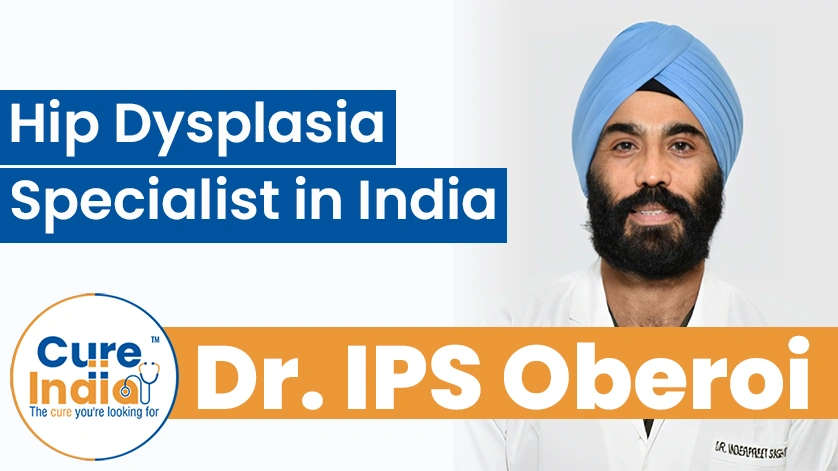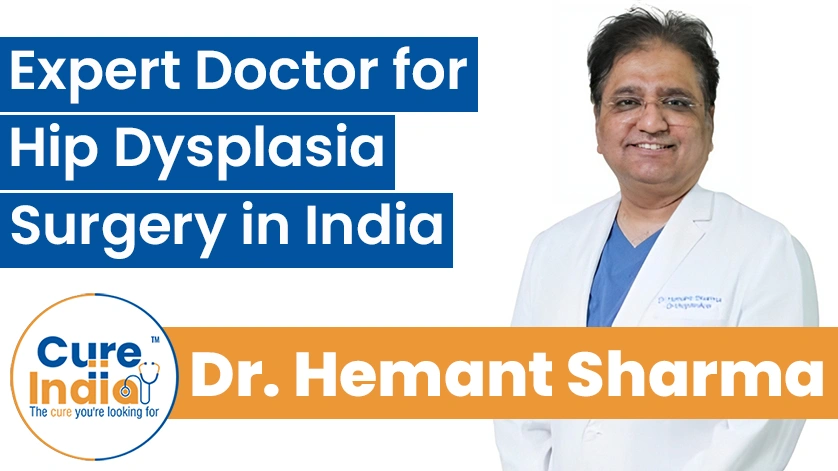

Hip Dysplasia is a congenital deformity of the hip where the ‘ball and socket joint’ of the hip is not formed properly. Congenital hip dysplasia can affect both or one hip of the child. It is more common in baby girls than baby boys. It is also a common developmental hip dislocation in Africa. Every year thousands of people from Kenya, Tanzania, Nigeria, and Ethiopia visit India for high-quality and affordable hip dysplasia treatment.
India offers the cheapest hip dislocation treatment for both kids and adults. Here, you can access world-class hip dysplasia treatment with cutting-edge hospital infrastructure, globally renowned hip dysplasia surgeons, trained medical staff and more. So, if you are searching for quality hip dislocation treatment, you can opt for India. Today, we will discuss everything you need to know about congenital hip dysplasia, including types, treatments, causes, costs, and more. Learning about these things helps you make informed decisions about the best treatment for hip dysplasia.
Hip dislocation or congenital hip dysplasia has many causes. It can occur due to several environmental and genealogical reasons. Learning about the potential causes of Hip Dysplasia can help prevent the condition and take proper preventive measures for babies with a risk of developing hip dysplasia. Below, we will discuss some common causes of Hip dysplasia briefly-

During the final month of pregnancy, the space in the womb becomes very crowded, which leads to a space crunch causing trouble in the baby's hip development. The hip joints in babies are made with soft cartilage tissues that harden with time. But if the womb space is too small, the hip ball can move out of the socket. As a result, the socket also develops narrowly. Here are several factors that cause womb space shortage-
Other factors that increase the risk of hip dysplasia-
Babies having a family history of hip dysplasia, such as fathers, mothers, siblings, and grandparents, are more likely to develop hip dysplasia.
According to the records, girls are more likely to develop congenital hip dysplasia than boys. One girl in every 600 girls has hip dysplasia, and one boy in every 3,000 boys develops hip dislocation.
Being the first child also increases the risk of developing hip dysplasia or developmental hip dislocation.
Hip dysplasia can be divided into different types depending on the severity level and how it affects the baby's lower parts and limbs. Here are different developmental hip deformity types discussed below:
In this condition of acetabular dysplasia, the ball is placed within the socket; however, the socket is very narrowly developed and fails to hold the joint ball within the socket properly.
In dislocatable hip dysplasia, the hip stays in a subluxated or normal position and the ball of the joint can be pushed out of the socket completely.
In this type of hip dysplasia, the ball is placed completely out of the socket when the child is sleeping or resting.
Subluxable is also one of the hip deformity types but comparatively rare compared to others. In this hip dysplasia, the ball is placed within the socket when the baby is resting. But during certain activities that involve pushing the hip, the ball can come out of the socket partially.
Subluxated is more severe than the subluxable hip dysplasia. In this condition, the ball is not placed inside the socket during resting; instead, it is located slightly away from the socket.
Dysplasia of the hip in infants is mostly curable with non-surgical treatments. However, the severity of the condition also influences whether they will need a surgical intervention or not. The surgical intervention for hip dysplasia can also be divided into different types of dysplasia, age of the patient and how the dysplasia has affected the hip area-

Since hip dysplasia in adults is also a possibility, hip osteotomy is one of the popular surgical procedures to treat dysplasia of the hip in infants and adults to correct the hip joint and improve the structure of the hip. Hip osteotomy helps to bring back the ball into the socket and tighten the socket around the ball to prevent further dislocation.
Another essential surgical intervention for hip dysplasia is hip arthroscopy. It is mostly prescribed when hip dysplasia is causing arthritis and troubling the normal movement of the child or adult. It is one of the best treatment for hip dysplasia.
Hip reduction surgery is also a popular surgical method for repairing hip dysplasia. It helps to improve the condition by reducing the space between the socket and the ball of the hip joint. The reduction surgery can be performed in both ways, open and closed, depending on the needs and preferences.

Hip dysplasia is a condition where the hip socket doesn't fully cover the ball portion of the upper thigh bone and leads to joint instability and potential arthritis. Early diagnosis and surgical interventioncan help prevent long-term complications. India boasts specialised orthopedic surgeons who are known for their expertise in treating hip dysplasia. Some of the leading hip dysplasia surgeons in India are:
Dr. Manoj Miglani is a leading hip dysplasia surgeon in India with expertise in hip reconstruction, joint preservation, and corrective surgeries. He specialises in treating developmental hip dysplasia, pediatric & adult hip deformities, and total hip replacement.

Dr. Nitiraj Oberoi is a top hip dysplasia surgery doctor in India, with extensive experience in corrective hip procedures, hip replacement, and complex orthopedic surgeries. He is known for treating congenital and developmental hip disorders, using advanced surgical techniques that promote faster recovery and optimal joint function.

Dr. I.P.S. Oberoi is a hip dysplasia specialist in India with expertise in performing hip deformity correction, joint preservation surgery, and reconstructive hip procedures. He has successfully treated patients with developmental dysplasia, femoroacetabular impingement, and early-onset osteoarthritis.

Dr. Hemant Sharma is an expert doctor for hip dysplasia surgery in India, with expertise in minimally invasive hip surgeries, hip replacement, and corrective orthopedic procedures. He treats congenital and developmental hip disorders, osteoarthritis of the hip, and post-traumatic hip deformities.

The cost of hip dysplasia treatment is quite expensive than other treatments globally. However, the cost of hip dislocation treatment like hip replacement in India is relatively cheap and affordable. The average cost of hip dysplasia treatment in India ranges from around $2,400 to $5,400 depending on the type of treatment you are going to get.
Also, several other factors can influence the overall treatment cost of hip dysplasia in India such as the type of treatment you are going to get (surgical or non-surgical), the location of the treatment, the reputation of the hospital and the qualification of the surgeon.
| Treatment | Cost in India | Stay in India |
|---|---|---|
| Unilateral Hip Dysplasia Treatment in India | $4,500 | 14 days |
| Bilateral Hip Dysplasia Treatment in India | $9,000 | 14 days |
Robotic hip replacement is the most recent medical development for hip dysplasia treatment. The technique involves replacing the injured knee joint with an artificial one with the help of a robot. It blends robotic technology with traditional surgical techniques to improve precision, accuracy, and surgical outcomes.

In a robotic-assisted hip replacement, a robotic arm assists the surgeon in planning and performing the surgery with excellent accuracy. The surgeon remains in charge, but the robotic arm gives direction and real-time data during the procedure. This improves implant insertion precision and saves recovery time.
Robotic hip replacement surgery is an extremely advantageous procedure for patients. The advantages of a robotic hip replacement operation are:

The Stryker MAKO is a popular robotic system in India for hip replacements. It employs preoperative CT scans and a robotic arm to plan and carry out the hip surgery with high precision. MAKO provides a more predictable hip replacement procedure with accurate implant placement and precision. This robotic device offers surgeons real-time data and feedback to help them improve surgical outcomes and recuperation times.

Meril Life Sciences created CUVIS, an innovative robotic-assisted surgery system. This is India's first completely automated robotic joint replacement system. It gives a surgeon real-time 3D visualisation for pre-planning the surgery based on the patient's anatomy, followed by accurate cutting for the best surgical results. The technique makes use of modern motion-tracking technologies to improve accuracy and ensure that the procedure goes smoothly.
Hip dysplasia surgery can be divided into different types depending on the severity of the case and the age of the patient. As a result, there is no one surgical method available for hip dysplasia, also different types of surgery have their own unique procedure to correct the hip joint. So, the hip dislocation procedure will vary depending on the type of surgery you are going to have. Talking with your surgeon will help you get details about the procedure once the type of surgery is finalised.
Hip dysplasia treatment doesn't always refer to surgical intervention. It can also be treated with several non-surgical alternative treatments. In most cases, the surgical intervention is the last option preserved for the time when other non-surgical alternatives fail to work. If hip dysplasia is diagnosed in early childhood or the prenatal period, then the chances of non-surgical alternatives to resolve the issue are high. Here are some common non-surgical alternatives for hip dysplasia treatment-
The Pavlik harness is a soft brace used to treat hip dysplasia in infants. The doctor can suggest a Pavlik harness to bring the ball into the socket or the right position and hold it in the same position for several months to fix the problem.
A Spica cast is a type of body cast doctors prescribe to treat hip dysplasia in babies. It helps to move joint bones to their right position and keep them there. It takes 3-6 or more months to resolve the hip dislocation. It is also a popular hip dysplasia treatment for mild cases.
Lastly, specific exercise and body movement doctors can suggest for mild congenital hip dysplasia or newborn hip dysplasia cases. However, exercise and stretching can only work for very mild and flexible cases.
Hip dysplasia treatment recovery time depends on several factors: the severity of the condition, the types of treatment used, and the age of the patient. For example, non-surgical treatment can take up to 3 to 6 months to treat the condition; after that, you need to follow doctor-prescribed exercise.
On the other hand, if hip dysplasia involves surgical intervention, it will take 2 to 4 months for complete recovery. Within one week of the surgery, one can move using a crutch. After four weeks, they will be able to lift weights.
Hip dysplasia treatment is covered by most health insurance and Medicare policies to help you avail of the treatment without worrying about the cost of the treatment. However, it would be wise to check the list of coverage before buying any insurance policy. Also, if your current health insurance plan does not cover the cost of hip dysplasia, you can talk to your insurance provider to upgrade your existing plan and include hip dysplasia treatment or change your insurance provider if they do not offer coverage for hip dysplasia.


Globally Trusted Brands
Inquire Now
Knee, Hip and Shoulder Replacements
Share Your Reports
Computer Navigated and Keyhole Knee Surgeries
Recover Fast